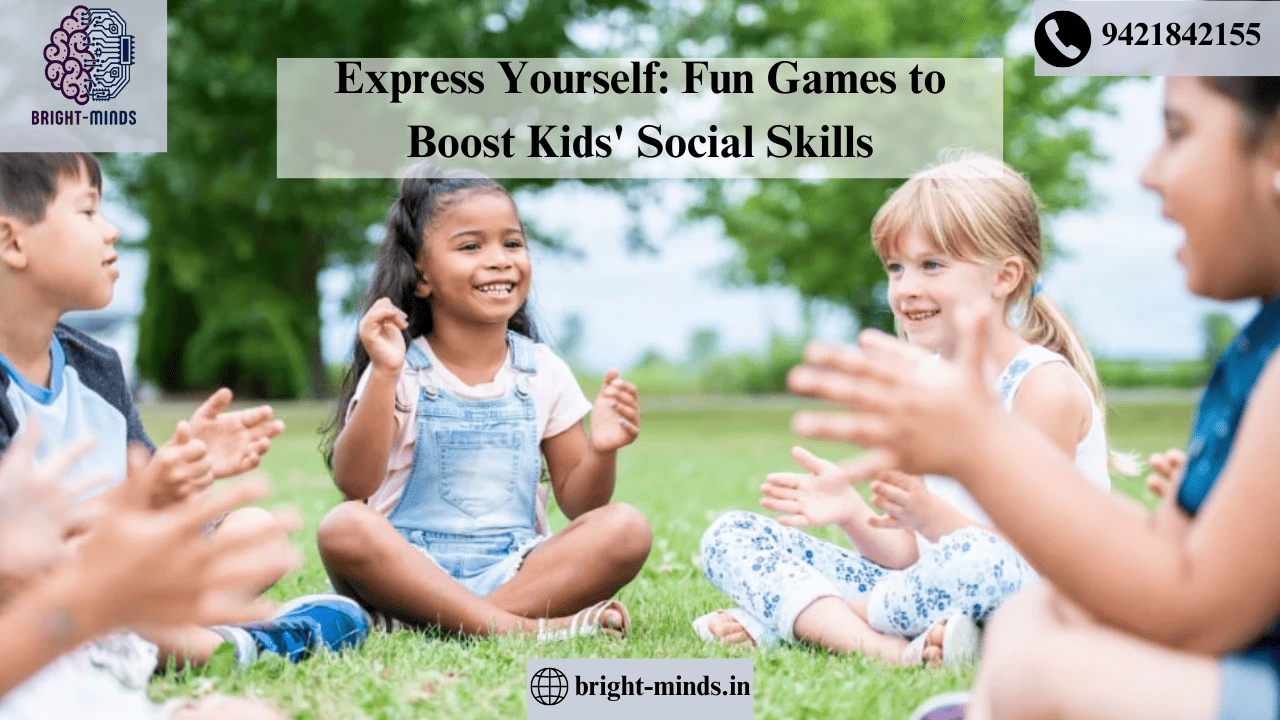Social skills are fundamental for kids to navigate the world around them, whether it’s making friends, participating in group activities, or resolving conflicts. These skills shape their ability to communicate, cooperate, and empathize with others. As children grow and develop, they learn to express themselves, understand social norms, and build meaningful relationships. One of the most effective ways to help children develop strong social skills is through play.
Fun games that encourage interaction, cooperation, and communication can create an engaging environment for kids to learn essential social skills. These activities provide children with opportunities to practice empathy, teamwork, and problem-solving—all while having fun. In this blog, we’ll explore several enjoyable games that can boost kids’ social skills and help them express themselves with confidence.

Why Social Skills Matter for Kids
Social skills are critical in a child’s development, impacting everything from academic performance to emotional well-being. Positive social interactions allow children to form friendships, express their emotions, and handle conflicts effectively. Strong social skills help kids collaborate in school projects, understand others’ perspectives, and communicate their feelings appropriately.
For children to build these skills, they need both structured and informal opportunities to practice. Social skill development can be enhanced through various games that focus on cooperation, listening, sharing, and resolving conflicts in a constructive way.
1. The Compliment Game
This simple yet powerful game teaches children the importance of kindness, positive reinforcement, and boosting others’ self-esteem. Complimenting others can help kids practice expressing their emotions and learn how to make others feel good about themselves.
How to Play:
- Have the children sit in a circle.
- One child gives a compliment to the person sitting next to them. For example, “I like your shoes,” or “You’re really good at drawing.”
- The child who receives the compliment then gives a compliment to the next person in the circle, and so on, until everyone has given and received a compliment.
Benefits:
- Promotes positive communication and helps children become more comfortable expressing their feelings.
- Encourages kindness and appreciation for others.
- Boosts children’s self-esteem as they receive compliments and acknowledge the strengths of their peers.
2. Emotion Charades
Emotion Charades is an exciting game that helps children identify and express emotions through non-verbal cues. It’s a great way for kids to become more aware of both their own feelings and the emotions of others, fostering empathy and emotional understanding.
How to Play:
- Write various emotions (happy, sad, angry, excited, etc.) on small pieces of paper and place them in a bowl or container.
- One child draws an emotion from the bowl and then acts it out without speaking.
- The other children try to guess the emotion being portrayed.
- After the emotion is guessed, discuss how different emotions can be expressed and how to respond to them in social situations.
Benefits:
- Helps kids become more aware of their emotions and learn how to express them appropriately.
- Teaches empathy by encouraging children to understand how others might be feeling.
- Improves non-verbal communication skills and facial expression recognition.
3. The Friendship Web
This cooperative game encourages kids to work together to create a “friendship web,” promoting teamwork and communication. It also teaches children the importance of supporting one another and relying on others for help.
How to Play:
- Have the children sit in a circle.
- Give the first child a ball of yarn and ask them to introduce themselves by saying something they like (e.g., “My name is Emily, and I like soccer”).
- The child then holds onto the yarn’s end and tosses the ball to another child across the circle, who must catch it, introduce themselves, and share something they enjoy.
- The process continues until everyone has spoken and there is a web of yarn connecting the children.
- Afterward, discuss how the web shows how all the kids are connected and how teamwork makes the group stronger.
Benefits:
- Fosters teamwork and cooperation.
- Helps kids learn to listen and support each other in social settings.
- Strengthens the concept of connection and inclusivity within a group.
4. Pass the Ball Questions
Pass the Ball Questions is a fast-paced and interactive game that helps children practice their listening skills, take turns, and respond thoughtfully to questions. It encourages kids to express themselves and share their thoughts with others.
How to Play:
- Have the children sit in a circle and pass a ball around.
- When the music stops or a timer goes off, the child holding the ball must answer a question about themselves. Some example questions include:
- “What’s your favorite book?”
- “What do you like to do with your friends?”
- “What makes you happy?”
- After answering, the child passes the ball to the next person, and the game continues.
Benefits:
- Encourages children to express themselves and share personal thoughts in a safe, non-judgmental environment.
- Promotes turn-taking and respect for others’ opinions.
- Helps kids build confidence in speaking and listening.
5. Role-Playing Scenarios
Role-playing is a great way for children to practice social interactions and problem-solving. By acting out different scenarios, kids can practice how to handle various social situations, such as meeting new people, resolving conflicts, or helping others.
How to Play:
- Prepare a list of social scenarios (e.g., introducing yourself to someone new, asking to join a game, apologizing after an argument).
- Assign different roles to the children (e.g., the child who wants to join the game, the child who is being approached).
- Have the children act out the scenario, using appropriate language and body language.
- Afterward, discuss the role-play and explore alternative ways to handle the situation.
Benefits:
- Helps children develop problem-solving skills by practicing real-life social situations.
- Teaches conflict resolution strategies and how to communicate effectively in challenging situations.
- Encourages kids to empathize with others by considering different perspectives.
6. Group Storytelling
Storytelling is an excellent way for children to use their imagination, practice communication, and work together. In a group storytelling activity, children learn how to build on one another’s ideas and contribute to a shared narrative.
How to Play:
- Begin a story with a simple sentence, such as “Once upon a time, there was a little dragon who loved to explore.”
- Each child adds one sentence to the story, continuing the narrative.
- The story can go in any direction, and the fun lies in seeing how the children collaborate to create something unique.
Benefits:
- Encourages collaboration and active listening as children build on each other’s ideas.
- Stimulates creativity and helps children practice both verbal and non-verbal communication.
- Fosters a sense of community as children work together to create a collective story.
7. Collaborative Art Projects
Creating art together is a fun and effective way for children to practice communication and teamwork. When working on a collaborative art project, children learn how to share ideas, delegate tasks, and respect each other’s contributions.
How to Play:
- Provide a large piece of paper or canvas and a variety of art supplies (crayons, markers, paint, etc.).
- Ask the children to work together to create a group artwork.
- Encourage them to discuss ideas and share materials while respecting each other’s choices and contributions.
- After the artwork is completed, have the children reflect on the process and how they collaborated to create the piece.
Benefits:
- Promotes teamwork, cooperation, and communication.
- Enhances problem-solving skills as children discuss and decide on the direction of the artwork.
- Encourages creativity and self-expression in a group setting.
8. Simon Says
“Simon Says” is a classic game that helps children practice listening skills, following directions, and recognizing non-verbal cues. It’s a fun and active way to engage kids while teaching them the importance of paying attention and following instructions.
How to Play:
- One child is chosen to be “Simon” and gives commands (e.g., “Simon says touch your toes,” or “Simon says jump up and down”).
- If Simon gives a command without saying “Simon says,” the other children should not follow the command.
- Children who follow a command without hearing “Simon says” are out.
- The game continues until only one child remains.
Benefits:
- Teaches kids the importance of listening carefully and following instructions.
- Helps develop focus and concentration.
- Encourages physical activity while reinforcing social rules.
Conclusion
Games are a fantastic way to help children express themselves and develop essential social skills. Whether it’s through role-playing, storytelling, or cooperative activities, these games provide kids with the opportunity to practice communication, empathy, teamwork, and problem-solving. By making social skill development fun and interactive, children can gain the confidence they need to build strong relationships, handle conflicts, and express themselves clearly in a variety of situations. As they grow and develop, these skills will serve them well, both socially and emotionally.
Also Read:
https://bright-minds.in/unlocking-word-meaning-for-class-ukg-english-to-hindi/

